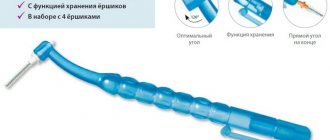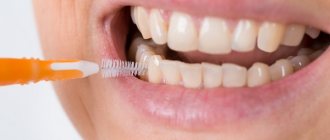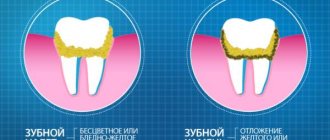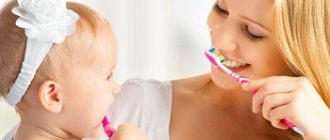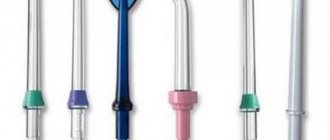While wearing braces, careful oral care is necessary .
For these purposes, various means are provided (special brushes, dental floss, irrigators, etc.).
And one of such effective devices is brushes for braces .
They are designed to clean the interdental space and braces from stuck food particles.
Also, brushes have a massaging function and, thereby, prevent bleeding gums.
For your information! Today they are produced in a wide variety (in size and shape) and everyone can choose the option that suits personal preferences and certain needs.
Why do you need to use special brushes for cleaning with braces?
It is worth using brushes for cleaning, because they are able to eliminate even the smallest particles of food , which inevitably remain in the interdental space and in the braces themselves .
Ordinary this 100% .
As a result, colonies of pathogenic microorganisms form in the oral cavity, subsequently leading to the initial stage of caries and other adverse consequences.
Keep in mind! Regular use of these brushes helps keep your teeth clean and healthy.
At the same time, the brace system used retains a well-groomed appearance longer.
Oral-B Clinic Line Ortho (USA)
If you're shopping for orthodontic toothbrushes for braces, consider Oral-B Ortho. This is an inexpensive option, but at the same time quite high quality and effective. Price – from 200 rubles.
This model has a rubberized ribbed handle that prevents slipping in the fingers during cleaning and excessive pressure on soft and hard fabrics. The head is narrow and long, which is good for penetration into the most inaccessible and remote1 areas of the oral cavity. Polyamide bristles are soft and do not accumulate bacteria for a long time.
Oral-B Clinic Line Ortho
What happens if you don't use it?
If you do not use special brushes for cleaning, then in the future there may be such negative consequences as:
- Formation of tartar (due to the accumulation of plaque in hard-to-clean places).
- Darkening and thinning of tooth enamel.
- The emergence and development of caries.
- Darkening of the metal arches of the bracket system itself.
To avoid various risks, it is recommended to use such brushes regularly. Otherwise, the method does not guarantee 100% results.
Types of brushes for braces
Some patients mistakenly believe that after installing braces it is not necessary to purchase additional hygiene products and tools.
They believe that the desired effect can be achieved with the help of an ordinary toothbrush, but experts have a different opinion on this matter. Important! Research results1 and the practical experience of dentists confirm the fact that a low level of oral hygiene while wearing braces doubles the risk of developing caries.
In the vast majority of cases, caries forms in the immediate vicinity of the plates, that is, in those places that are most difficult to clean, especially with a regular toothbrush. In addition, patients who neglect hygiene during treatment experience pronounced yellowing of the enamel after removing the braces.
Caries after braces
So, all brushes designed to maintain hygiene while using an orthodontic structure are divided into several main types:
- V-neck model: A brush for braces that has shorter bristles in the center. If you look at the head from the end, you can see hairs that resemble the shape of the Latin letter “V”. Experts say that such a medium makes it possible to most effectively clean the surface of tooth enamel and plates from contaminants,
- special brush: this tool can have different lengths, diameters and degrees of rigidity. It is better to choose a brush together with the treating orthodontist, who, if necessary, can take additional measurements,
- mono-tuft brush: a product with one tuft of bristles, which allows for thorough cleaning of surfaces that are inaccessible to a regular brush. The product can be characterized by different hardness, so before purchasing it, again, it would be a good idea to consult with your orthodontist.
Read about how to properly clean braces in our special article {amp}gt;{amp}gt;{amp}gt;
Types of devices
You should know! Orthodontic brushes are classified according to several criteria. So, the following varieties are distinguished:
- By bristle hardness : soft, medium and hard. Patients with hypersensitive teeth are recommended to use brushes with soft bristles.
- The shape of the bristles : cylindrical, curved and conical. Cylindrical bristles have the same length over the entire surface of the rod and are intended not only for braces, but also for cleaning wide interdental spaces and caring for gums. Curved - the most expensive option, in which the rod and handle have a semicircular shape. This type of device is considered the most effective means of cleaning braces. Conical, in turn, have cone-shaped bristles (the longest bristles are located at the base, and the shortest at the top). They can be used for daily cleaning of braces and teeth.
- Handle length : short and long. In this case, experts advise focusing solely on your preferences (what length of handle will be most comfortable to hold).
- By size of interdental spaces : small, medium and wide. In this case, the size is selected by the hygienist (after measuring the interdental space).
- By length of the bristles : with short and long bristles. The length of the short bristles is 1 mm and is used for cleaning narrow lateral edges, the long bristles are 3 mm, indicated for wide interdental spaces.
- By product length : there are sizes XS, S, M, L and XL in increasing order (accordingly, size XL is the largest).
- Operating principle : manual and electric. The second option is considered more effective in terms of cleaning braces and tooth enamel from plaque and food debris.
It is worth noting! A dentist or hygienist will help you choose the best brush option.
After all, convenience and comfort during the cleaning process is the key to a healthy and beautiful smile.
Irrigator or interdental brushes? What to choose?
Every person knows from childhood that to maintain oral hygiene you need to use toothpaste and a brush. But not everyone knows that a regular brush cannot always cope with plaque and food debris in the crevices between the teeth. The distances between the teeth are small enough for the brush to clean these spaces from bacteria, plaque, food debris, etc., which can lead to the formation of tartar, caries and inflammatory processes of the gums. When wearing braces, bridges, or implants, some difficulties arise, primarily related to hygiene. It is very difficult to clean teeth from food debris that gets stuck under the arch of braces, brackets and attachment points. Therefore, it is important to choose the right tool for careful maintenance. Only a dentist can completely remove all dental deposits, so professional hygiene must be done every six months. And at home, to maintain a good level of hygiene, you need to brush your teeth twice a day with a toothbrush and toothpaste - and additionally clean the spaces between your teeth using dental brushes and an irrigator.
Who needs dental brushes and irrigator?
- For those who wear braces, bridges, implants
- For those who drink a lot of strong tea and coffee, as well as for those who smoke
- For those with sensitive gums
- For those who have too small or large interdental spaces
- For ordinary people who closely monitor the condition of their oral cavity
In order to understand which of the proposed devices is better, we will conduct a comparative analysis.
Benefits of dental brushes:
- The brush consists of a handle and a rod with bristles. All brushes have different diameters, lengths and stiffness of bristles. What allows a person to choose the size he needs in accordance with the individual characteristics of the dentition
- If you have braces to correct your bite, dentures or bridges, the quality of teeth cleaning is reduced. A brush for cleaning teeth will help to cope with this problem, so for people with braces it is simply necessary
- their use is much more convenient than using dental floss
- they are safer than toothpicks because they cannot damage tooth enamel or gums
- have an additional unique property - they massage the gums, stimulating blood circulation in them and helping to strengthen
- effectively clean enamel from coffee, tea or tobacco stains, and also remove plaque that causes bad breath
- the small width of the villi allows them to penetrate into the periodontal pocket, cleaning the crowns below the gum line, which is a good prevention of gum inflammation
- the cost is lower than that of irrigators
Disadvantages of dental brushes:
- It is very important that the size of the brush is selected correctly and individually. To do this, you need to contact your dentist, who, using special calibration probes, will measure each interdental space and select the right brush size for you.
- many types of brushes are disposable
- require frequent replacement, which means material costs. It is recommended to change the brush every week (maximum use time is two weeks), even if visually it does not look deformed
- the cost of dental brushes may vary, but it is not recommended to purchase too cheap ones - their bristles quickly wrinkle and deform, which reduces the quality of cleaning
- Only when used correctly does a brush successfully remove food debris from the interdental spaces. Therefore, you need to learn the technique and devote enough time to effectively clean your mouth.
If you do not want to perform monotonous movements on your own or cannot master the correct technique, you can purchase special electric brushes or irrigators complete with a dental brush attachment. This is a device that consists of a reservoir for liquid and a handle with a nozzle for rinsing the interdental spaces.
Advantages of irrigators:
- After brushing your teeth with a brush and paste, you use an irrigator. This helps clean hard-to-reach spaces between teeth and prevent the formation of tartar.
- Cleans teeth and braces more effectively than brushes. A stream of water or a medicinal solution supplied under pressure better penetrates the interdental spaces and areas between the elements of the dental structure and washes out even microscopic food debris.
- massages the gums, improving their blood circulation
- indispensable for those who have crowns, bridges or braces, as well as for people with bleeding gums, frequent food getting stuck in the interdental spaces, crowded teeth (very close arrangement)
- a nozzle for interdental spaces, which can be used for an irrigator, is much safer than brushes, incorrect or careless handling of which can damage the bracket system
- There are several types of attachments, the choice of which depends on the purpose, orthodontic, periodontic, for cleaning the tongue
- perfectly cleans the space between teeth, while doing all the work for you
- The cleaning process using irrigators is much faster than when cleaning with a brush
Disadvantages of irrigators:
- high cost, but this is a one-time purchase and will last for a long time. Cleaners are cheaper, but you have to buy them much more often
- takes up more space in the bathroom
- higher noise level
- There is a danger of electric shock - do not touch the operating device with wet hands or use it when taking a bath or shower; do not immerse the irrigator in water
- requires regular washing and drying of nozzles, a special place for storing nozzles
If you are in doubt about what to buy: an irrigator or brushes, we recommend that you use a two-in-one product: an irrigator with attachments for cleaning interdental spaces.
Dental center Dentalpik (Dentalpik) Pro 50
Portable irrigator Dentalpik Pro 50 with a built-in battery, made in an ergonomic design. Effectively cleans the interdental spaces, removes plaque, and also prevents the formation of tartar and is an excellent prevention of caries and periodontal disease. An oral irrigator is necessary for caring for dentures, crowns and braces. The Dentalpik Pro 50 irrigator is easy to operate, convenient for transportation and use outside the home. Thanks to the built-in battery, the irrigator can maintain operation for up to 2-3 weeks without recharging. Additionally, there are orthodontic attachments and attachments for cleaning the tongue. In addition to the irrigator, the dental center's equipment includes the Dentalpik Pro 50 Ultrasonic Toothbrush. It operates at a frequency of 48 kHz, which is 48 thousand vibrations per minute, at a sound frequency of 42,000 mechanical movements per minute, which enhances the antibacterial and cleansing effect of the brush. 3 operating modes and improved battery. And the Dentalpik dental mirror with anti-fog coating and LED backlight will allow you to look into the most inaccessible places in your mouth, evaluate the quality of cleaning and the level of plaque on the inner surface of the teeth.
Dental center Oral-B Professional Care OxyJet Center +3000
This is a comprehensive system for caring for the entire oral cavity for superior cleanliness. Consists of an electric toothbrush and irrigator. Removes up to 97% of plaque from hard-to-reach areas of the oral cavity. The Oral-B Professional Care OxyJet irrigator is stationary. By turning on the Turbo flow mode, the mini-turbine built into the head of the nozzle is activated, which, spinning up to 8000 rpm, forms a spiral-shaped jet stream that easily penetrates under the edge of the gums, destroying bacteria, food debris, massaging the gums, and preventing periodontal diseases. Monoflow - a direct, directed jet stream attacks bacterial plaque, washing away food debris between teeth, around implants, crowns, bridges and orthodontic structures. The irrigator automatically turns off after 10 minutes of operation if you forget to turn it off manually, to prevent overheating. The Oral-B Professional Care electric toothbrush has a unique 3D technology: 40,000 pulsating movements/min, 8800 reciprocating movements/min. The pressure sensor, when the brush is pressed firmly on the surface of the tooth, automatically turns off the pulsating movements, thereby ensuring safe cleaning, preventing your teeth and gums from over-cleaning.
Irrigator Waterpik WP-100 Ultra E2
Effectively removes oral bacteria. Penetrates deeply between the teeth and under the gums, where a toothbrush and dental floss cannot reach. Ideal for improving the condition of gums during periodontitis and periodontal disease, as well as preventing these diseases during pregnancy and lactation, with diabetes, and in smokers. It has a quiet electric motor, 10 pressure levels and a set of 7 nozzles. One of the most useful attachments is for the hygienic care of dentures, bridges and implants. It allows you to spray an antibacterial solution or just water beyond the gingival margin, cleaning the periodontal pockets. Next is the necessary mono-beam brush attachment, which allows you to wash hard-to-reach areas and braces with a powerful jet. The nozzle with a nozzle for cleaning the tongue is made in the shape of a spoon. Periodontal nozzle with a soft rubber tip of a cone shape. It allows you to accurately direct the stream of liquid without injuring the gums with the plastic part, which is indispensable for cleaning gum pockets and massaging the gums. The irrigator is also equipped with an orthodontic attachment, which, thanks to the presence of a small brush at the end, allows you to effectively clean braces.
In conclusion, we note that for the best oral hygiene, it is recommended to use the following set: toothpaste, toothbrush, dental brush and irrigator:
- A toothbrush and toothpaste are the main means for cleaning the visible surface of teeth.
- A dental brush is the main tool for cleaning interdental spaces from food debris.
- An irrigator is the main tool for cleaning hard-to-reach places and strengthening gums
A dental brush is a good tool for cleaning the interdental space. However, people often do not master the regular and correct use of a dental brush for a number of reasons: laziness, limited physical capabilities, or the presence of orthodontic structures in the oral cavity. An irrigator is a more advanced device that allows you to remove food debris from places that are inaccessible even to brushes. It generates a strong stream of water, which easily penetrates both hard-to-reach places and deep periodontal pockets. The irrigator is indispensable for people who have crowns, implants, bridges, braces, veneers and can improve the condition of people with periodontitis, periodontal disease and bad breath. It is recommended to use brushes for cleaning teeth in combination with irrigators and special rinses designed for oral care. When used correctly and regularly, they will ensure healthy teeth and gums for a long time.
If you have any questions, we will help you choose from more than 40 models of irrigators and brushes presented on our website, just call us at: +7
How to choose the right one?
When choosing a suitable device, you must consider the following important nuances :
- Length of bristles - if the teeth fit tightly together, then it is better to choose a product with short bristles. If there are small gaps between the teeth, then a product with long bristles would be an ideal option.
- Brush length - small sizes are suitable for children, larger sizes for adults (L, XL).
- Bristle hardness - dentists advise choosing products with medium bristle hardness. But people with sensitive or damaged enamel should give preference to soft brushes.
- The length of the handle of the product should be based on personal considerations of comfort during cleaning. Some people find it convenient to hold a product with a short handle, others with a long handle.
- Product quality - it is advisable to choose products from well-known brands, after studying consumer reviews.
According to dentists, the most convenient to use are cone-shaped brushes.
They not only effectively clean braces, but also interdental spaces, eliminating plaque and bacteria accumulation.
Where to buy and how much does it cost?
Dentists advise purchasing interdental brushes after prior consultation with them.
The doctor will help you choose the right size and shape. You can buy it in online stores of official dealers of companies that produce dental products.
Brushes are available in pharmacies and stores that sell medical equipment, particularly dental products.
The cost of dental brushes starts from 150 rubles and can reach up to 2,000 rubles per set. The kit includes a different number of brushes - 3, 5 or more pieces. On average you will have to pay 400-700 rubles for them.
Prices depend on the brand of the manufacturer, the hardness of the bristles and their shape. The presence of orthodontic structures and implants is also taken into account - special models are produced for cleaning them. They are more expensive than regular ones.
General tips for use
Stay up to date! Using these products is quite simple. However, it is necessary to take into account a number of the following rules:
- Before using the brush, be sure to brush your teeth in the usual way (using toothpaste and a regular brush).
- Bring the device to the interdental spaces (hold the device perpendicular) and gently massage the required areas of the teeth and the brace system (especially metal arches).
- It is advisable clean after every meal .
- After each use, the brush must be rinsed with warm water and then closed with a cap (included in the kit).
- Carry out the procedure without using special cleaning products (paste or tooth powder).
- Change the product as often as possible (if the fibers lose stiffness), on average once every 2-4 weeks .
In the first days of using the brush, the gums may bleed a little , which is quite normal for the adaptation period.
Remember ! However, if such symptoms persist for a week and your teeth hurt, you should consult a doctor for advice.
Can I use an electronic toothbrush?
While wearing braces, many people prefer an electric brush, which is quite justified. Using this device, you can easily and fairly quickly get rid of plaque accumulation on the surfaces of plates and teeth. However, orthodontists do not recommend using this brush if you have braces, since strong rotation of the head can damage the system. It is also better not to use ultrasonic brushes, as they can lead to fragmentation of the adhesive and peeling of the plates from the surface of the teeth.
- According to the European Association of Orthodontists.
Sequence of application
the cleaning device as follows:
- Rinse the product under running water.
- the brush one by one into the interdental spaces and, using soft circular movements, clean the enamel surface with a regular brush . Do not move up and down (like dental floss). Do not touch the incisors.
- Then place the bristles of the product between the arch of the bracket system and the enamel . Make light movements (clockwise).
- Rinse the brush with warm water and close the cap. Remove until next use.
Remember! To maintain oral hygiene, you can also use special rinses, for example, Listerine, etc.
They will help cope with plaque and prevent caries.
Popular manufacturers
Today, many manufacturers produce special brushes for cleaning braces, but not all of them are of high quality.
So, the most effective products are from the following brands :
- Lacalut (lacalut) - products are equipped with a metal rod made of hypoallergenic materials, covered with insulating plastic. This reduces trauma during use. Average price: 300 rubles and above.
- Colgate Total (colgate) – a distinctive feature of this product is that the products are produced in a set, which includes brushes with different bristle lengths. The cost of the product is on average 250-270 rubles.
- Miradent - are available in the form of a set that includes 4 brushes with ultra-soft bristles and a wire rod. The products differ from each other in the length and thickness of the bristles, as well as the diameter of the rod. The cost of the set is 500 rubles.
- Oral-B (oral bi) – products are cylindrical and cone-shaped, sold in small containers (include 1 pc.). Also available in sets. The price ranges from 250 to 400 rubles.
- Curaprox (curaprox) - products are made from a special alloy that is used in the surgical industry. The brushes produced under this brand are of high quality and have a long service life. Therefore, they cost around 1000 rubles.
Products from the above brands are not only highly effective, but also absolutely safe to use.
Range
To care for the corrective product, a set of orthodontic brushes is used:
- with a V-shaped neckline;
- monobeam;
- pipe cleaners;
- electric.
This is a device in which the bristles have an uneven height, i.e. it is shorter in the middle than on the sides. Looking at it from the end, you can clearly see that the pile in the center has a cutout in the form of a Latin letter V, and on the sides it is of standard height.
This feature allows you to simultaneously remove plaque from the enamel and parts of the orthodontic apparatus. This is possible due to the tight fit of the bristles to the teeth and structure.
Long bristles along the edges clean the surface of the enamel and interdental spaces, and short bristles clean the bracket clasps and arch. When making bristles, soft fibers are used, which during use do not damage or harm the corrective product.
When using a brush, it is important to consider the following features of the process:
- The procedure begins with cleaning the lingual, incisal and vestibular parts of the teeth using sweeping movements.
- Then, using the same technique, from the gum line to the edges of the teeth, the locks are cleaned.
- The arc is processed with horizontal movements, and the V-shaped cut should be on the arc.
Mono-beam
The product is intended for spot treatment of teeth, interdental crevices and orthodontic product parts. It simultaneously combines the functions of two tools: a toothpick and a regular brush.
In appearance, the brush looks like an elongated thin stick with a small rounded head on top. The device has a unique head design that distinguishes it from all other brushes.
It is equipped with only 1 bundle of fibers, the diameter of which does not exceed 10 mm, and the length is slightly larger than the standard size. The head is positioned vertically relative to the base. These features of the brush allow you to perform very high-quality cleaning and reach remote, hard-to-reach areas.
Its main advantage is that, having a small head, it allows the procedure to be carried out for each individual brace or tooth.
The product is available in different versions, differing in the shape of the fibers. To care for the corrective apparatus, orthodontists recommend using cone-shaped bristles. Long bristles in the center penetrate into the gaps of the locks, and shorter bristles at the edges clean the surfaces of the structure.
Treatment of the oral cavity is carried out according to the following rules:
- the brush should be positioned at right angles to the surface of the teeth;
- the procedure begins from the gum line to the cutting surface;
- Next, the braces are cleaned.
Braces should be cleaned as follows:
- the locks are processed in a circular motion with a brush located perpendicular to the braces;
- Using sweeping movements, the arc is cleaned along its entire length.
The remaining parts and segments of the device are cleaned in the same way.
Cleaners
Designed for the treatment of orthodontic products and interdental spaces. They look very much like household brushes, but only very small in size. They easily penetrate hard-to-reach areas that are inaccessible to a classic brush.
They consist of a holder and a working part (nozzle with bristles). They differ from each other in the length of the product itself, the shape of the working part, the stiffness and size of the bristles, and the length of the handle.
To clean braces, it is recommended to use products with a conical nozzle and soft bristles. Their upper narrow part cleans the parts of the corrective device, and the lower wide part cleans out food debris from the interdental spaces. The daily number of procedures for cleaning the orthodontic apparatus with brushes is at least 2 times.
Treatment of braces is performed in the following sequence:
- brush your teeth first;
- Use a brush to work the locks back and forth;
- clean the arch: insert the device between it and the teeth, and carefully rotate it along the axis;
- The arch on the outside of the tooth is cleaned in the same way.
If you use them every day, you need to change the attachments on your brush every week.
Electrical
This model is popular. It efficiently removes deposits from teeth and appliances in a short period of time. The frequency of rotation of its head exceeds the number of movements that a person makes with a regular brush.
The device is designed so that it can perform pulsating or rotating movements when switching modes. Many models are supplemented with an ultrasonic emitter, which promotes loosening and subsequent separation of plaque.
When purchasing an electric brush, you should pay attention to the presence of:
- mode regulator;
- speed controller;
- presence of additional modes;
- timer.
If these devices are used incorrectly and cleaning for a long time, they lead to deformation and breakage of the orthodontic structure.
The fixation elements may become unstable if the procedure is performed at high speed of rotation of the head. Ultrasonic radiation affects the structure of the glue, which will inevitably lead to the braces coming off the teeth.
Important: to prevent the use of an electric brush from causing damage to the corrective apparatus, it is necessary to select the correct model and reduce the procedure time to 1.5-2 minutes.
What is an electric brush for braces?
An electric brush is a device for cleaning braces and interdental spaces .
The bristles of the product vibrate due to the built-in electric motor.
Power comes from either a battery or a rechargeable battery.
Using this brush allows you to quickly and easily clean braces and tooth enamel from plaque and stuck food debris .
Therefore, this type of brushes is becoming increasingly popular.
Useful video
From this video you will learn how to properly care for braces:
Brushes for cleaning braces are an important element of complete oral care. They provide excellent protection of the enamel and bracket system from plaque and pathogenic bacteria .
At the same time, they are easy to use. With their help, you can not only protect yourself from problems such as caries and tartar, but also extend the life of the product.
The most important thing is to make the right choice by first studying the characteristics of a particular brush. Then convenience and comfort during the cleaning process are ensured.
General rules for caring for braces
If you want to maintain healthy teeth, you must follow the general rules for caring for braces. Let's describe them briefly:
- For braces, special toothbrushes are used that allow you to clean the enamel and all elements of the orthodontic structure.
- Treatment of the oral cavity should be performed 4-5 times a day or more often (after all meals, as well as in the morning and evening).
- It is necessary to clean not only the teeth themselves, but also all accessible surfaces of the braces.
- It is advisable to buy toothpaste with a high content of fluoride and calcium to increase the protective properties of the enamel. For the paste to be effective, it is recommended to regularly change it to a product from another company, since the enamel gets used to a certain composition and stops reacting to it.
- If you cannot clean some places, you should resort to the help of additional devices: dental floss, special brushes, etc.
- If you use rinse aid, do not use regular brands, but only ones that do not contain alcohol or dyes.
The main task of caring for the oral cavity while wearing braces is to preserve the enamel. This can be done in different ways. Read for interest what scientists are offering today: Scientists have found a way to protect tooth enamel in cancer patients...
